I love Namuwongo, it’s where I first fell in love with Uganda but I’m sure many Ugandans would shudder hearing that. Like many other Kampala slums, Namuwongo slums have a history: they were a no-go area for many years. It’s no des res (desirable residential) address, that’s for sure, but things are changing.
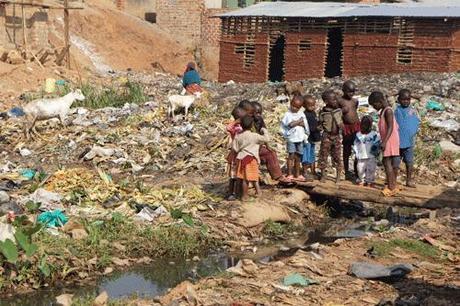
Slum children are frequently ill and are forced to live and play in terrible conditions. PHOTO Hope for Children
Clinging to the railway that connects Port Bell on Lake Victoria and the city of Kampala, are Namuwongo’s slums – or ‘high density housing’ to give them their posh term.
The Nakivubo Channel discharges large volumes of water into the slum, a combination of industrial waste and the run-off water from the high lying areas of Kampala, contaminating water in the wells and springs on which 30 to 40,000 slum-dwellers depend. Houses on the lower section of the slum are frequently flooded, homes and possessions destroyed by water, rubbish and human waste, spreading disease and unimaginable misery. Situated on and next to the mosquito-infested swamp, life in the slum presents a constantly high risk of malaria.
The majority of the slum’s population come from the war-torn zones of Northern Uganda, Congo and Rwanda. Others have migrated from Kenya using the railway line. There is a high birth rate.
Namuwongo slums are in Bukasa, Makindye Division, one of Kampala’s five major divisions. International Hospital Kampala and IHSU International Health Sciences University are just 1 km from the slum. In 2012 IHSU researched the health of the slum’s population, interviewing over 800 local residents, resulting in some major changes…
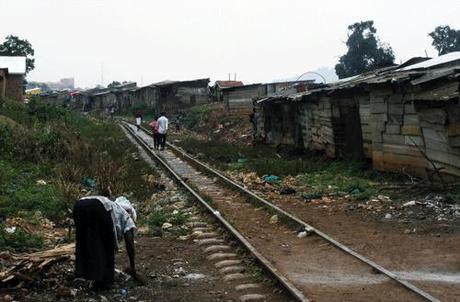
A typical scene along the railway through Namuwongo slums, Kampala
No one would choose to live in Kampala’s slums … or would they? The fact is that more than half the surveyed reported Namuwongo’s slums to be better than where they had lived before.
BLOODY HELL.
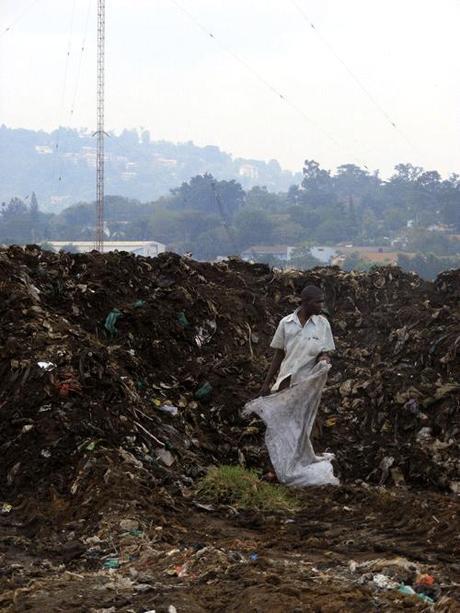
Hand sorting through the ten thousand tons of rubbish in the hope of finding something to sell. PHOTO Hope for Children
I try and imagine what life is like ‘down’ – down in the Kampala slums.
You know how debilitating an upset stomach can be? Imagine you have lots of kids who have nowhere else to play but in a sewage-infested area. Think of all the germs they bring home. Imagine how often they’re ill…
The thing is, only 10% of Namuwongo’s slum households have toilets and the average cost to use the public latrine is 200 shillings per visit.
But let’s do the maths: nearly 40% of respondents have a monthly income of just 2,500 shillings – less than a dollar. That’s not a dollar a day, but A DOLLAR A MONTH. (Incidentally, 98% of those were women). 65% of respondents have less than 100,000 shillings (35 USD) per month and 88% have less than 250,000 (95 USD) per month.
So how do you pay for all these toilet visits, especially if a member of your family is sick? Well the answer is you can’t. You go behind a bush or you improvise: wrapping your waste in a cavera (plastic bag) to make a ‘flying toilet.’
Bye bye flying toilets!
When toilets are free, people will use them, meaning a cleaner environment, less spread of disease and a healthier, happier population. Six blocks of latrines are being built, free for the local community to use.
This is being provided by Hope for Children, a UK charity that works with street children in Kampala, through their project Events for Namuwongo. Additional infrastructure is being constructed for waste management, recycling and very cheap clean water, all under the one Public Private Partnership Agreement, a project in partnership with KCCA and the Makindye Mayor’s office.
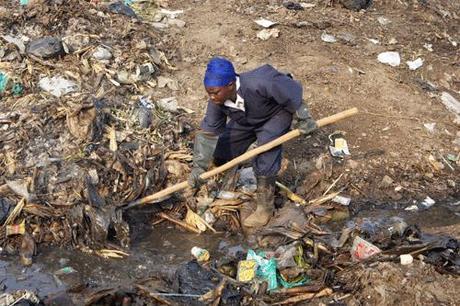
Clearing rubbish in Namuwongo, Kampala slums. PHOTO Hope for Children
Moving a mountain
A ten thousand ton waste mountain was cleared from this Kampala slum last year. Makindye Division Mayor and fellow Hash House Harrier Dr Ian Clarke mobilised KCCA to provide the diggers and Rift Valley Railways transported it for free.
Since then, concrete drainage systems have been built, substantially lessening the chance of homes flooding. The creation of free rubbish dumps and recycling facilities – and stopping people from dumping rubbish in the drainage ditches – has improved the situation immeasurably.
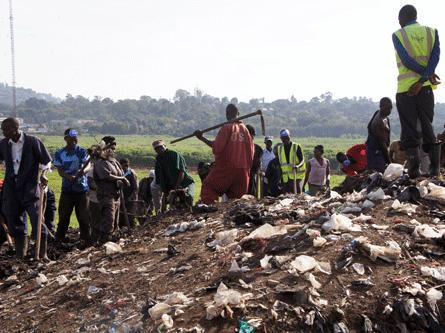
Hope for Children have employed hundreds of people from the local community to help clean up Namuwongo slums, Kampala. PHOTO Hope for Children
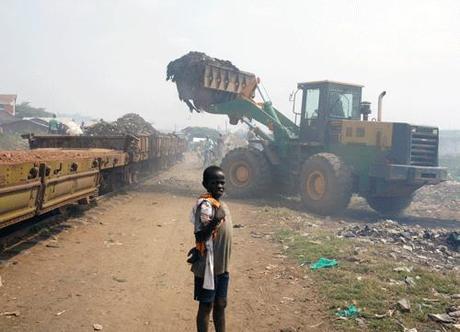
Local boy looks on as the Rift Valley Railways train is loaded with rubbish. It took several week-ends to clear the 10,000 tons of rubbish from Namuwongo slums, Kampala. PHOTO Hope for Children
Rift Valley Railways have also contributed 50 metres of land either side of track for the development of this project.
You can lead a horse to water…
Most residents collect water from a communal tap or a protected spring. 80% of people boiled water before drinking it but children are at risk of Cholera and Typhoid, often drinking unboiled water from the tap or Jerry can.
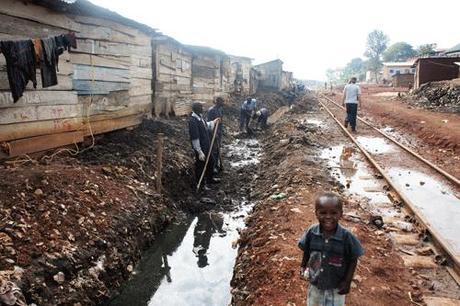
Work underway to first clear the rubbish and then dig foundations for the new concrete drainage ditches or ‘drainages’ in Namuwongo, Kampala slums. PHOTO Hope for Children
National Water are putting in a new ‘loop’ of piping which will create more water points throughout the slums and provide water for the new latrines. Twenty litres of water will cost just 22 Ugandan shillings, as opposed to the current 100 shillings ( 3 US cents) and it will be accessible via a token system and paid for by Mobile Money. (Poor people’s access to mobile phone technology in Uganda still amazes me – I bet you can’t pay for your water by SMS in the UK yet!) This heavily subsidised ‘pro poor water supply’ has already been successfully piloted in the Kampala slums of Bwaise and Gisenyi.
Keeping up the good work
This project will continue to employ hundreds of local people: community sensitisation teams that encourage people to make use of the new rubbish and recycling facilities and who offer information on family planning and HIV counselling; the de-silting team that unblock the drains of rubbish and tons of marram road run-off and dirt washed downhill every time it rains. KCCA will take on some of the project maintenance, including emptying of latrine septic tanks.
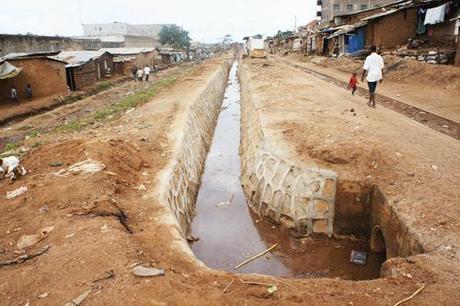
Free of waste, the new concrete drainages allow rainwater to pass through the slums without flooding homes. PHOTO Hope for Children
People seem happier
Hope for Children report that there’s been a very positive community response to the improvements so far – and it’s still early days.
“People seem a bit happier down there” says Thomas… “they are seeing the benefit of the work and are becoming more proactive, caring for the environment around them.”
With the majority of the work still under construction, the real positive impacts remain to be seen – but promise to be life-changing for thousands of people.
Meet my mad friend Robert!
If you’d like to support the work of Hope for Children, programme manager and friend Robert would love you to support him and this BONKERS proposal to run the Marathon Des Sables (MdS), the world’s toughest footrace: a 6 day, 156 mile run through the Moroccan Sahara Desert that’s taking place this April.
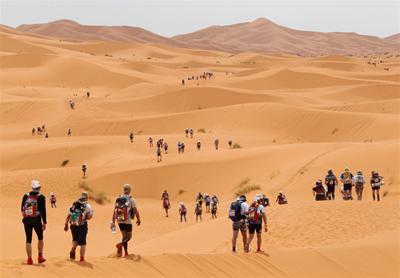
Robert is putting himself through HELL to run in 50 degree temperatures for SIX DAYS in the cross Sahara Marathon des Sables. Let’s help him get through it! for Hope for Children and their Namuwongo Kampala slums project
Robert writes:
“I have been silly enough to sign up for the Marathon des Sables one last time in order to raise funds for a project that HOPE for Children support in Uganda. I took part in this event three years ago and the side effects included the inability to walk for two weeks afterwards and the loss of several body parts.
We will be running in temperatures hovering at around 50 degrees centigrade, across sand dunes that tower several hundred metres high, stretching for 10-15 miles and made of sand so soft you sink up to your knee. No good for sandcastles and even less fun to run over.
If you could help me support these kids, I’d be immensely grateful. The pain I will undoubtedly go through will not be anything compared to the suffering these kids have been through and continue to go through every day.”

